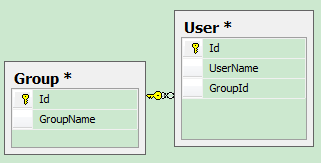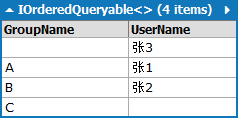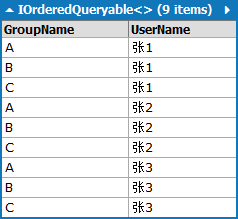我们知道在SQL中一共有五种JOIN操作:INNER JOIN、LEFT OUTER JOIN、RIGHT OUTER JOIN、FULL OUTER JOIN、CROSS JOIN
1>先创建两个表Group、User,两表的关系是N:N


CREATE TABLE [dbo].[Group](
[Id] [int] IDENTITY(1,1) NOT NULL,
[GroupName] [nvarchar](50) NULL,
CONSTRAINT [PK_Group] PRIMARY KEY CLUSTERED
(
[Id] ASC
)WITH (PAD_INDEX = OFF, STATISTICS_NORECOMPUTE = OFF, IGNORE_DUP_KEY = OFF, ALLOW_ROW_LOCKS = ON, ALLOW_PAGE_LOCKS = ON) ON [PRIMARY]
) ON [PRIMARY]
CREATE TABLE [dbo].[User](
[Id] [int] IDENTITY(1,1) NOT NULL,
[UserName] [nvarchar](50) NULL,
[GroupId] [int] NULL,
CONSTRAINT [PK_User] PRIMARY KEY CLUSTERED
(
[Id] ASC
)WITH (PAD_INDEX = OFF, STATISTICS_NORECOMPUTE = OFF, IGNORE_DUP_KEY = OFF, ALLOW_ROW_LOCKS = ON, ALLOW_PAGE_LOCKS = ON) ON [PRIMARY]
) ON [PRIMARY]
2>测试数据



INSERT [dbo].[User] ([Id], [UserName], [GroupId]) VALUES (1, N'张1', 1) INSERT [dbo].[User] ([Id], [UserName], [GroupId]) VALUES (2, N'张2', 2) INSERT [dbo].[User] ([Id], [UserName], [GroupId]) VALUES (3, N'张3', 4) INSERT [dbo].[Group] ([Id], [GroupName]) VALUES (1, N'A') INSERT [dbo].[Group] ([Id], [GroupName]) VALUES (2, N'B') INSERT [dbo].[Group] ([Id], [GroupName]) VALUES (3, N'C')
3>连接大全

Sql:
SELECT [t0].[GroupName], [t1].[UserName]
FROM [Group] AS [t0]
INNER JOIN [User] AS [t1] ON ([t0].[Id]) = [t1].[GroupId]
Linq to Sql:
from g in Groups
join u in Users
on g.Id equals u.GroupId
select new { GroupName=g.GroupName, UserName=u.UserName}
Lambda:
Groups.Join
(
Users,
g => (Int32?)(g.Id),
u => u.GroupId,
(g, u) =>
new
{
GroupName = g.GroupName,
UserName = u.UserName
}
)


Sql:
-- Region Parameters
DECLARE @p0 NVarChar(1000) = ''
-- EndRegion
SELECT [t0].[GroupName],
(CASE
WHEN [t2].[test] IS NULL THEN CONVERT(NVarChar(50),@p0)
ELSE [t2].[UserName]
END) AS [UserName]
FROM [Group] AS [t0]
LEFT OUTER JOIN (
SELECT 1 AS [test], [t1].[UserName], [t1].[GroupId]
FROM [User] AS [t1]
) AS [t2] ON ([t0].[Id]) = [t2].[GroupId]
Linq to Sql:
from g in Groups
join u in Users
on g.Id equals u.GroupId
into Grp
from grp in Grp.DefaultIfEmpty()
select new { GroupName=g.GroupName, UserName=(grp==null)?"":grp.UserName}
Lambda:
Groups.GroupJoin (
Users,
g => (Int32?)(g.Id),
u => u.GroupId,
(g, Grp) =>
new
{
g = g,
Grp = Grp
}
) .SelectMany (
temp0 => temp0.Grp.DefaultIfEmpty (),
(temp0, grp) =>
new
{
GroupName = temp0.g.GroupName,
UserName = (grp == null) ? "" : grp.UserName
}
)


Sql:
-- Region Parameters
DECLARE @p0 NVarChar(1000) = ''
-- EndRegion
SELECT
(CASE
WHEN [t2].[test] IS NULL THEN CONVERT(NVarChar(50),@p0)
ELSE [t2].[GroupName]
END) AS [GroupName], [t0].[UserName]
FROM [User] AS [t0]
LEFT OUTER JOIN (
SELECT 1 AS [test], [t1].[Id], [t1].[GroupName]
FROM [Group] AS [t1]
) AS [t2] ON [t0].[GroupId] = ([t2].[Id])
Linq to Sql:
from u in Users
join g in Groups
on u.GroupId equals g.Id
into Grp
from grp in Grp.DefaultIfEmpty()
select new { GroupName=(grp==null)?"":grp.GroupName, UserName=u.UserName}
Lambda:
Users.GroupJoin (
Groups,
u => u.GroupId,
g => (Int32?)(g.Id),
(u, Grp) =>
new
{
u = u,
Grp = Grp
}
).SelectMany (
temp0 => temp0.Grp.DefaultIfEmpty (),
(temp0, grp) =>
new
{
GroupName = (grp == null) ? "" : grp.GroupName,
UserName = temp0.u.UserName
}
)


Sql:
-- Region Parameters
DECLARE @p0 NVarChar(1000) = ''
DECLARE @p1 NVarChar(1000) = ''
-- EndRegion
SELECT DISTINCT [t7].[GroupName], [t7].[value] AS [UserName]
FROM (
SELECT [t6].[GroupName], [t6].[value]
FROM (
SELECT [t0].[GroupName],
(CASE
WHEN [t2].[test] IS NULL THEN CONVERT(NVarChar(50),@p0)
ELSE [t2].[UserName]
END) AS [value]
FROM [Group] AS [t0]
LEFT OUTER JOIN (
SELECT 1 AS [test], [t1].[UserName], [t1].[GroupId]
FROM [User] AS [t1]
) AS [t2] ON ([t0].[Id]) = [t2].[GroupId]
UNION ALL
SELECT
(CASE
WHEN [t5].[test] IS NULL THEN CONVERT(NVarChar(50),@p1)
ELSE [t5].[GroupName]
END) AS [value], [t3].[UserName]
FROM [User] AS [t3]
LEFT OUTER JOIN (
SELECT 1 AS [test], [t4].[Id], [t4].[GroupName]
FROM [Group] AS [t4]
) AS [t5] ON [t3].[GroupId] = ([t5].[Id])
) AS [t6]
) AS [t7]
Linq to Sql:
var a=from g in Groups
join u in Users
on g.Id equals u.GroupId
into Grp
from grp in Grp.DefaultIfEmpty()
select new { GroupName=g.GroupName, UserName=(grp==null)?"":grp.UserName};
var b=from u in Users
join g in Groups
on u.GroupId equals g.Id
into Grp
from grp in Grp.DefaultIfEmpty()
select new { GroupName=(grp==null)?"":grp.GroupName, UserName=u.UserName};
var c=a.Concat(b).Distinct();
c.Dump();
Lambda:
Groups
.GroupJoin (
Users,
g => (Int32?)(g.Id),
u => u.GroupId,
(g, Grp) =>
new
{
g = g,
Grp = Grp
}
)
.SelectMany (
temp0 => temp0.Grp.DefaultIfEmpty (),
(temp0, grp) =>
new
{
GroupName = temp0.g.GroupName,
UserName = (grp == null) ? "" : grp.UserName
}
)
.Concat (
Users
.GroupJoin (
Groups,
u => u.GroupId,
g => (Int32?)(g.Id),
(u, Grp) =>
new
{
u = u,
Grp = Grp
}
)
.SelectMany (
temp2 => temp2.Grp.DefaultIfEmpty (),
(temp2, grp) =>
new
{
GroupName = (grp == null) ? "" : grp.GroupName,
UserName = temp2.u.UserName
}
)
)
.Distinct ()


Sql:
SELECT [t0].[GroupName], [t1].[UserName]
FROM [Group] AS [t0], [User] AS [t1]
Linq to Sql:
from g in Groups
from u in Users
select new { GroupName=g.GroupName, UserName=u.UserName}
Lambda:
Groups.SelectMany
(
g => Users,
(g, u) =>
new
{
GroupName = g.GroupName,
UserName = u.UserName
}
)

Linq实现LEFT OUT JOIN
原文地址:http://geekswithblogs.net/AzamSharp/archive/2008/04/07/121103.aspx
Suppose you have a tblRoom and tblUserInfo. Now, you need to select all the rooms regardless of whether the room has user information or not. This calls for a LEFT JOIN which will select everything from the LEFT side (the room side) regardless of the join on the right side. Here is the example.
假如你有两张表tblRoom(房间表)和tblUserInfo(住户表)。现在你需要检索出所有房间的信息,而不管这个房间是否有人居住。这就需要进行LEFT JOIN(左外连接),左外连接会检索出LEFT JOIN左边表中的所有行,而不管右边的表是否有匹配项。下面是一个例子:
var list = from r in dc.tblRooms
join ui in dc.tblUserInfos
on r.UserName equals ui.UserNameinto userrooms
from ur in userrooms.DefaultIfEmpty()
select new
{
FirstName = (ur.FirstName == null) ? "N/A" : ur.FirstName,
LastName = (ur.LastName == null) ? "N/A" : ur.LastName,
RoomName = r.Name
};
The anonymous type replaces the "null" FirstName and LastName with "N/A" (not available).
使用"N/A"(不可得)代替 FirstName 和 LastName 值为"null"的情况。
另附:Linq实现多个表 LEFT JOIN 如下
来自:http://hi.baidu.com/xuejianxiyang/item/0c9df0175c8dbdfaddeecae3
目标SQL语句(多表 LEFT JOIN 查询)
- 目标SQL语句(多表 LEFT JOIN 查询)
- SELECT id, name, jname, cname
- FROM userinfo u
- LEFT JOIN job j on u.job = j.jid
- LEFT JOIN city c on u.city = c.cid
Linq To Sql 实现三个表 LEFT JOIN 如下:
- var list = (
- from u in dc.userinfos
- join j in dc.jobs on u.job equals j.jid into j_join
- from x in j_join.DefaultIfEmpty()
- join c in dc.cities on u.city equals c.cid into c_join
- from v in c_join.DefaultIfEmpty()
- select new
- {
- id = u.id,
- name = u.name,
- jname = x.jname,
- cname = v.cname,
- /*u1=u,x1=x,v1=v*/
- //不要用对象的方式 因为对象可能为null那么对象.属性就会抛异常
- }
- ).ToList();
- for (var i = 0; i < list.Count(); i++)
- {
- Console.WriteLine(list[i].name + '\t' + list[i].jname + '\t' + list[i].cname); //字段为null不报异常
- //Console.WriteLine(list[i].u1.name+'\t'+list[i].x1.jname+'\t'+list[i].v1.cname+"\r\n"); //对象x1 v1 有可能为null 抛异常
- }
- Console.ReadLine();
我用Linq自己写的3个表 LEFT JOIN 例子:
Emp(员工表)、Dept(部门表)、KqEmp(人员考勤信息表)
- 顶
- 0
南来地,北往的,上班的,下岗的,走过路过不要错过!
======================个性签名=====================
之前认为Apple 的iOS 设计的要比 Android 稳定,我错了吗?
下载的许多客户端程序/游戏程序,经常会Crash,是程序写的不好(内存泄漏?刚启动也会吗?)还是iOS本身的不稳定!!!
如果在Android手机中可以简单联接到ddms,就可以查看系统log,很容易看到程序为什么出错,在iPhone中如何得知呢?试试Organizer吧,分析一下Device logs,也许有用.



